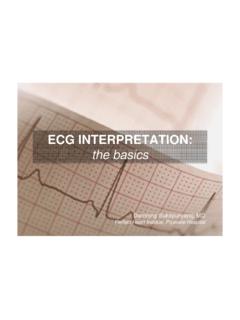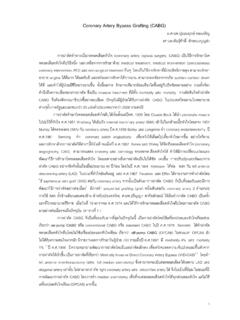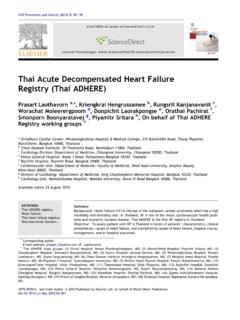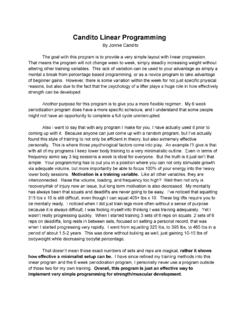Transcription of Principles of exercise prescription for patients with ...
1 Principles of exercise prescription for patients with chronic heartfailureJonathan MyersPublished online: 16 October 2007 Springer Science+Business Media, LLC 2007 AbstractChronic heart failure (CHF) is a common anddebilitating condition characterized by reduced exercisetolerance. While exercise training was once thought to becontraindicated for patients with CHF, a substantial bodyof data has been published over the last two decades tosupport the use of exercise programs for these in exercise capacity, quality of life.
2 Andmortality have been demonstrated among patients withCHF who have participated in formal exercise prescriptionis a means of assessing and inter-preting clinical information and applying the Principles oftraining to develop an appropriate regimen so that thesebenefits are achieved. The major Principles of the exerciseprescription are themode, frequency, duration, and inten-sity. Importantly, safe and effective exercise prescriptionfor patients with CHF requires more than the application ofthese Principles ; it also requires careful consideration of theindividual patients functional status, comorbid conditions,medications, contraindications, and personal goals andpreferences.
3 Recent studies have demonstrated that a widespectrum of patients with CHF benefit from appropriatelyapplied exercise training, including those with both systolicand diastolic dysfunction, atrial fibrillation, pacemakers,implantable cardioversion devices, and post-cardiac ,theprinciplesofexerciseprescription are included as a component of comprehensiveCHF management programs. Evidence has accumulatedthat CHF patients who participate in rehabilitation pro-grams have better health outcomes in terms of reducedmorbidity and mortality, as well as lower hospitalizationrates and lower overall health care failure Rehabilitation exercise testing Heart diseaseThe hallmark symptom of chronic heart failure (CHF) isexercise intolerance, often exhibited by early fatigue orshortness of breath with a minimal degree of exertion.
4 Thepathophysiologic features of CHF that underlie reducedexercise tolerance have been the focus of numerousinvestigations the last two decades [1,2]. These involveboth central (cardiac) and peripheral (skeletal muscle andvascular) abnormalities, including impaired cardiac outputresponses to exercise , abnormal redistribution of bloodflow, reduced mitochondrial volume and density, impairedvasodilatory capacity, and heightened systemic vascularresistance [1 4]. The reduced exercise tolerance thatcharacterizes CHF has profound implications for thecapacity to perform daily activities, disability, quality oflife, and prognosis.
5 Thus, one of the principal goals oftreatment in CHF is to improve exercise the late 1980s, patients with CHF were commonlyexcluded from rehabilitation programs due to concernsover safety, whether training caused further harm to analready damaged myocardium, and questions as to whetherthese patients could benefit from rehabilitation. Theseconcerns have been allayed by numerous studies performedover the last two decades documenting that exercisetraining in patients with CHF is safe, that training causesno further damage to the myocardium, and that rehabili-tation programs have been associated with numerousphysiological, musculoskeletal, and psychosocial benefitsJ.
6 Myers (&)Cardiology Division (111C), VA Palo Alto Health Care System,Stanford University, 3801 Miranda Ave., Palo Alto, CA 94304,USAe-mail: Fail Rev (2008) 13:61 68 DOI [1,5]. However, this population presents some uniquechallenges for exercise programming . In this article, theunderlying Principles of aerobic exercise prescription forpatients with CHF are to the patient with CHFP rior to beginning an exercise program, all patients with aconfirmed CHF diagnosis require a comprehensive clinicalevaluation, including treatment of underlying causes ofCHF, optimal pharmacologic therapy, and risk stratifica-tion (Table1).
7 The clinical approach to the patient withCHF who is considered for an exercise program is similarto that of the post-myocardial infarction patient with nor-mal ventricular function, although several importantdifferences are worth noting. While serious events duringexercise are extremely low in all patients [6], the risk forsudden, arrhythmic events is a greater concern in patientswith CHF. There are often more medications that caninfluence exercise responses, including vasoactive, antiar-rhythmic, inotropic, and beta-blocking agents.
8 There aremore comorbidities to consider, and an increasing pro-portion of these patients have bi-ventricular pacemakers orimplantable cardioversion devices (ICDs). Importantly, exercise capacity tends to be significantly lower than that inthe typical patient with coronary artery extent to which exercise capacity is impaired inCHF is typically 30 50% relative to age-matched normalsubjects and is 20 30% lower than that among typicalpatients with coronary disease [1,7,8].
9 These impairmentsmay be even more pronounced in women with CHF [9].Numeroushemodynamicabnormalitiesunde rliethereduced exercise capacity commonly observed in CHF,including impaired heart rate responses to exercise , aninability to distribute cardiac output normally, abnormalarterial vasodilatory capacity, abnormal cellular metabo-lism in the skeletal muscle, higher than normal systemicvascular resistance, higher than normal pulmonary arterypressures, and ventilatory abnormalities that increase thework of breathing and cause exertional dyspnea [1 4,8,10].
10 While studies performed over the last two decadeshave demonstrated that many of these abnormalities can beimproved by exercise training [1,5,8,9,11,12], they areimportant considerations prior to beginning an exerciseprogram for the patient with patients with reduced left ventricular function whoare clinically stable and have reduced exercise toleranceare candidates for exercise programs. Stability can beassured by the absence of recent changes in body weight,the absence of recent changes in symptoms, and control ofcomorbid conditions.












